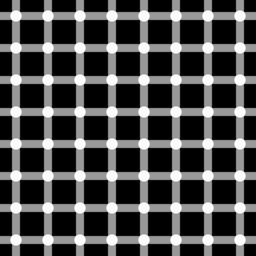Our visual experience with the
world is one of the most important factors that make us enjoy the world around
us. It facilitates our understanding with our environment and helps us
distinguish safe from dangerous. No doubt, our sense of sight has aided us with
our communication and interaction with other people. But what if we find out
that, just like anything (or anyone), it also can deceive us?
Let’s take a close look at three selected illusions (influenced by the author's bias) that we sometimes assume to be real
yet... so not.
This is an example of a motion illusion. It is sometimes difficult experience motion but focusing the eye at the right spot will give you the product of the illusion. Certain explanations as to how we perceive the motion in a static drawing has been proposed. According to Bach and Poloschek (2006) "The eye movements affect temporal modulation with the help of either adaptation or possibly saccadic suppression. A grouping arrangement enhances the effect, but colour is not necessary."
Whether the illusion is colorful or composed with neutral shades, the illusion is caused by asymmetric luminance which triggered our perception of motion. The rule is, never assume it's going somewhere when it's obvious that it's not.
Another interesting illusion is the Hermann Grid illusion. In this illusion, we can see white or black dots at the intersections of the grid but when we fixate our eyes into one of them, those dots disappear. In truth, those dots do not really exist, it's just that "we see the world as our retinal ganglion cells encode and thereby compress it" (Bach & Poloschek, 2006). How can we trust ourselves now if even the cells in our bodies commit errors of judgment?
As the picture itself reveals its name, this is called Eye Color Optical illusion. "This is a case of simultaneous colour contrast, and probably also of colour adaptation" (Bach, 2014). Both eyes are of the same neutral gray shade yet one eye with the tint of pink (light red) on the surrounding appears to be bluish. Since the tint is red, it makes the neutral shade into the tint's opposite color, which is blue (simultaneous color contrast). As we continue to stare at it, the bluish color seems to intensify (color adaptation) and removing the pink (light red) tint around the eye will produce the same neutral gray color. This means that in perceiving a stimulus in front of us, the immediate surrounding influences our interpretation of the stimulus, whether we want them to or not.
Explaining optical illusions is a difficult matter, just as how it is difficult to not-believe them. Still, it is interesting to investigate about them and even more interesting to get fascinated on how they can deceive us explicitly.
Resources:
Bach, M. & Poloschek, C.M (2006). Optical Illusion. Visual Neuroscience. Vol. 6, No. 2 pp. 20-21
Bach, M. (2014). Retrieved from: http://www.michaelbach.de/ot/col-context/index.html



No comments:
Post a Comment